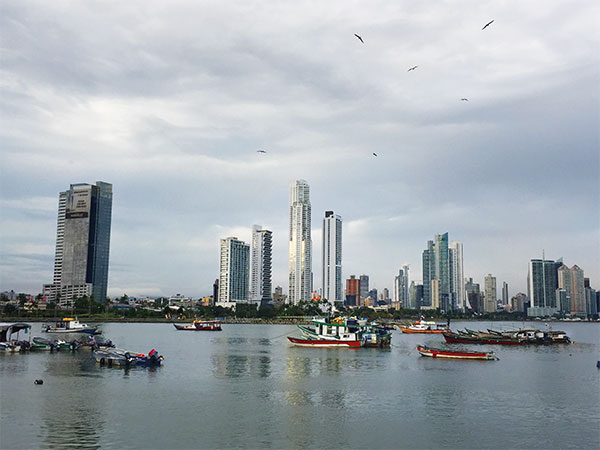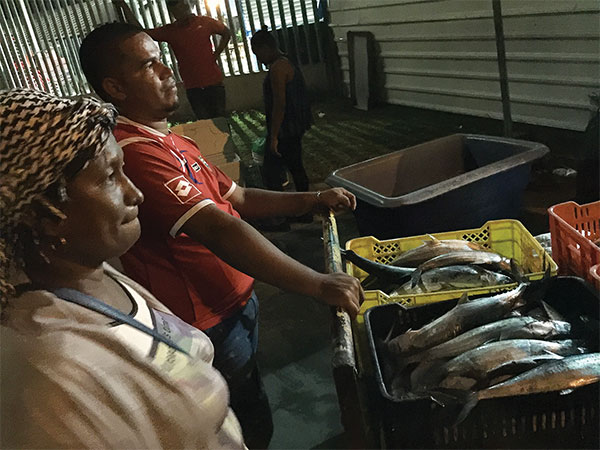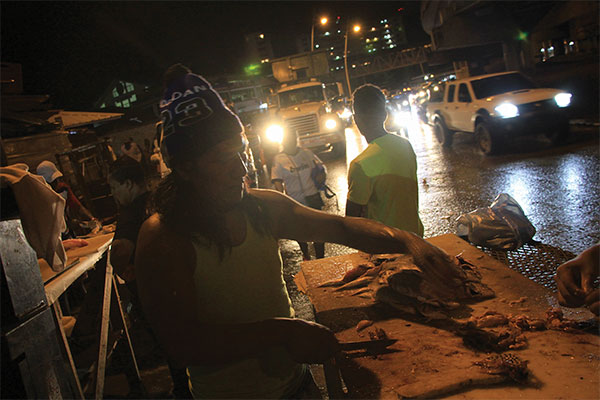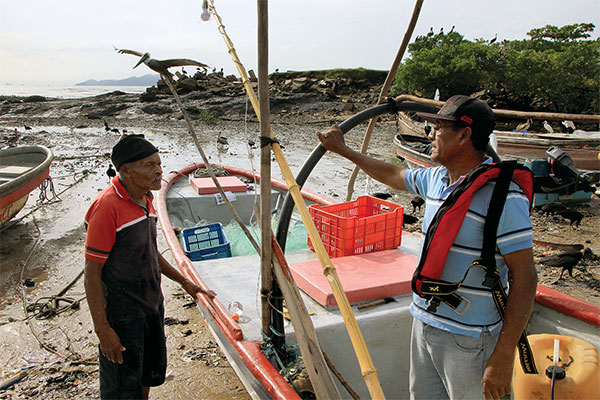Subtotal: $
Checkout-

Return to Idaho
-

The Glory of the Creatures
-

Poem: “The Path”
-

Poem: “The Berkshires”
-

The Secret Life of Birds
-

Why Children Need Nature
-

Made in the Image of God
-

The Lords of Nature
-

Editors’ Picks: The Opening of the American Mind
-

Editors’ Picks: Klara and the Sun
-

Writing in the Sand
-

City of Bees
-

Sister Dorothy Stang
-

Midwestern Logistical Small Talk
-

Covering the Cover: Creatures
-

Love in the Marketplace
-

The Elemental Strangeness of Foxes
-

Saints and Beasts
-

Astronomy According to Dante
-

The Book of the Creatures
-

Letters from Readers
-

Vulnerable Mission in Action
-

Community-Supported Agriculture in Austria’s Weinland
-

My Forest Education
-

Regenerative Agriculture
-

Into the Sussex Weald
-

The Abyss of Beauty
-

Let the Body Testify
-

Ernest Becker and Our Fear of Death
-

Singing God’s Glory with Keith Green

Miguel Rodríguez Uriola cannot help swaying as he talks. He has spent half of his sixty-four years at sea, and it is as if the earth were moving beneath him like water. He was fourteen when he made his first voyage. Back then, the only way out of the city by boat was through a narrow tidal waterway, rowing against the muddy current with all the strength his arms could muster. Now his boat, like the other thirty-nine vessels registered in Boca la Caja, is powered by motors.
He has just returned from a six-day job out on the Pacific. He’s sitting down by the entrance to the neighborhood, drinking a beer, the alcohol from the previous four already in his system. An outboard engine with clapped-out propellers hangs nearby, along with the shell of an old air-conditioning unit whose cooling days are long past.
Without letting the bottle fall, he gestures, as if throwing an imaginary trammel net, and says: “All this used to be wooden huts.”
Past a vegetable-oil factory, surrounded by buildings which shoot up into the clouds, one of the last fishing neighborhoods in Panama City is surviving. The majority of its inhabitants, like Miguel, make their living by fishing. They are the last fully urban fishermen in Panama. Today the only indication of the surviving trade is a cardboard sign with shaky handwriting that reads: “We have prawns: 3.50 dollar.”
Cars do not fit on Boca’s streets. It lies at sea level and below traffic level. There are, however, enough antennas to ensure that the television signal has no problem getting through the surrounding wall of skyscrapers.
Boca’s heart beats more slowly these days in the rapidly expanding concrete metropolis, in the middle of a large-scale development called San Francisco. The city has grown up around the neighborhood, and now acts as though it would rather not see it, like the remnants of an impoverished past, or a wound that must
be healed.
If you looked down from the sky, you’d see boats like Miguel’s floating, little spots of light close to the freight and cruise ships, which resemble buildings sleeping in darkness.
Its inhabitants are locked in a drawn-out battle with the government, entrepreneurs, and politicians. They don’t want to sell their land unless they get $4,000 per square meter, about $370 per square foot. A land appraisal carried out by state entities recommended less than $9 per square foot. Hungry real-estate agents and officials are lying in wait. Sometimes they show up to take photographs and measurements that no one wants them to take. Down among the shells of the old shacks, investors have glimpsed a shining pearl: undeveloped land, perhaps the last remaining in the center of Panama City.
Hens scuttle along the narrowing alleyways. Pink, aquamarine, and dark orange houses are crowded together, forming a labyrinth of balconies decorated by clothes hanging from washing lines. Addresses are scrawled on chalkboards. Five children play marbles in the cracks in the ground. You can’t look up at the clouds in the sky without a tower getting in the way, looming behind the corroded zinc roofs of the shacks’ first floors.
Miguel talks about fishing. “The system’s changed now. For the better. Before, you’d take the product and you couldn’t get rid of it. Twenty-five or thirty years ago you’d be earning ten, fifteen centavos a day.”
“But aren’t there fewer fish and more people fishing?”
“Yes – there’s no abundance. But now the product moves and it’s worth more. You sell to restaurants. You export. Sometimes the catch is poor” – he uses his longest fingernail to make a slicing gesture across his jugular vein – “so you have to go out again. No business, no life.”
At night, the sea around Panama City is dotted with lamps. If you looked down from the sky, you’d see boats like Miguel’s floating, little spots of light close to the freight and cruise ships, which resemble buildings sleeping in darkness.
Batteries and light bulbs play a key role in fishing off the shores of the canal. Because if they can’t see you, anybody transiting between the Atlantic and the Pacific could easily mow you down. Miguel hangs his lamps high, with bamboo canes. At night, the waves shake him unceasingly. It rains. The bursts of foam and cold winds fuse into one almighty chaos. Out at sea, his task is essentially to survive inside a washing machine going at full speed. He takes refuge in a cabin made from rods and tarpaulin. He bails out water with a bucket, his jacket and windbreaker drenched through. In the mornings he sizzles off under the sun and cooks the food he’s brought along, beef and rice, on a gas stove. He looks for a cove away from the trails of the mega-ships, to avoid being caught by the Coast Guard.
Sometimes he indulges in other fare. “The sea langoustine isn’t like the farmed one. Sure, you can take a chicken and tie it up and toss it some corn. But in the sea, psssh. Grab one, put it down there and see if it doesn’t bite you. The other ones, the farmed ones, have no flavor. …
They’re not like the ones you get from the sea.”
“So you eat what you fish?”
“Of course, man! You eat five or six first, before you sell them. That’s how it is.” He marks the midpoint of his forearm. “From the sea to your plate.”
Miguel leads us to Boca’s quay, at the other end of the neighborhood. He has left his boat aground on the mud, tied to a stick. When the tide comes in it will float up on the spot. Four unsmiling men are repairing a net on the shore. They cut nylon, they haul, they strain, they hammer on a log. As they see me approaching, their faces seem to say: “Who is this clown?” An office chair bobs up and down in the water, with bottles, cans, bags, broom bristles, and a group of small rotting boats. This is the headquarters of one of the four traditional fishermen’s associations registered in Panama City.
Day is here, coming up fast as it does in the tropics. Suddenly, our two hours’ tour and series of interviews are cut off by the gestures of a bare-chested young man with a shaved head and the dead eyes of a sea bass. Tattoos reach all the way up his neck. A cross beams out from his chest. He has come from nowhere. This is not a tourist area; we unsolicited intruders know better than to mess around. We follow him towards the edge of Boca.

All photographs courtesy of the author
Before Dawn
At four twenty a.m., María Vásquez returns to the shore to count her catch. It’s still dark and the sea is reflecting the shoals of buildings that rise up around it. The lights from the coast caress her boat as it dances in the quay outside the seafood market. It’s the last unloading of the day. A voice sings out from the radio of the man receiving her load: “Ese toro enamorao de la luna.” The bull who fell in love with the moon.
This dark woman, fifty-five years old and grandmother to seventeen, has brought in sixteen boxes today: some sixteen hundred pounds of colorful, meaty scallops, ripe and ready for the knife and the pan.
“Were you expecting more?”
“Mamá, it’s just you said it was more like forty,” Carlito Guzmán, her trusted distributor, replies.
“But I keep bringing them in and you sell them right off … that’s why you can’t see all of them.”
Her husband Abraham, sixty-seven, is waiting for her at home. He’s retired. These days their son, also called Abraham, eighteen years old and thin as a rake, is the one who actually goes out on a boat to face the waves. The woman writes everything down in a notebook while her son gets his hands dirty. When she ties up her headscarf, with its white ripples, María looks more like a pirate than a sailor. Her T-shirt is emblazoned with the shimmering English logo: “Get ready, it’s time to fly.” Her family is just one entry on the official register of more than eighteen hundred fishermen and women working on the shores of the canal.
Abraham Jr. starts his last job of the day by spreading the fish out like playing cards on a wooden table. This is how he counts and classifies the fruit of three days’ and nights’ toil on the Pacific Ocean.
The lights of a vehicle appear on the horizon every ten or fifteen minutes. An oscillating light from a lighthouse runs across the faces of the people in the marketplace. This is perhaps the only time of day transportation works. There are no traffic jams. The few cars there are cruise through the area like fish in water. Half the city is still immersed in a deep sleep, but here work began at twelve midnight, and it’s only halfway done.
Megahotels, megabanks, mega shopping centers, and mega residential developments dominate the view. There are so many of them that there is no longer much space left for the fishermen. The families whose anonymous labor supplies this many-tentacled market are forced into the corners to eke out a living. They who put the wonders of the sea onto tourists’ plates go about their work behind the backs of the towering edifices.
A trail of boxes, tanks, tables, and homemade scales forms a kind of reef, which spills out onto more than one lane of the road. The market is a tipping point on Balboa Avenue, the border between the Casco Viejo, the historic quarter, and modern Panama City.
They who put the wonders of the sea onto tourists’ plates go about their work behind the backs of the towering edifices.
If you approach the market from the shore at Cinta Costera, the highway some eighty meters away, Carlito’s scales are the first ones you’ll see. His stand emerges from the street corner like a peninsula. There are many more sets of scales behind it: seventy stalls spreading out towards the edges of Panama City’s fishing equipment retail store. The country itself gets its name from an Indigenous word meaning “abundance of fish and butterflies.” The omission of pelicans and vultures seems unjust when you notice the winged battalion keeping watch over the hustle and bustle from the rear side of the market’s roof.
Buyers, fishermen, and wholesalers extend a carnival of shouts and laughter through some two blocks of wet floors, beneath a bridge covered in faded graffiti. Trucks loaded with frozen fruits of the surf line up on the corners.
Carlito wears a golden chain around his neck. Thirty-eight years old, bald and portly, he might be a Caribbean Ninja Turtle; Donatello, perhaps. The negotiations begin, the push and pull with María. The prices vary depending on the size of the overall catch that day. Today he’s paying $1.25 per pound for Pacific sierra and one dollar for a pound of yellow jack, which he has quite a lot of already. In Panama, everyone counts dollars in the singular and very few use the local currency, the balboa, which they call “the Martinelli” in a candid commemoration of the president who came up with the new one-balboa coin, supposed to parallel the American dollar. They’re not minting it any more.
Ahmed, Carlito’s younger brother, is in charge of accounts and handles the money. He looks similar but taller, with a broader frame, dressed in red, with the look of someone who’s been awake all night because his neighbors were having a party he wasn’t invited to. He would be Raphael.
“This is a family business, my uncle started it. We’re all fishermen. We have twelve vessels. We sell to whoever’s buying.”
5:00 a.m.
The lights of cars and trucks are becoming more frequent, their horns closer. Emma del Mar is one of the small-scale buyers at the market. She walks among the baskets, holding bags in her hands. Her two daughters, Justine and Ayelis, drink café con leche by the roadside. They are laughing at the man who has just sold them the drinks. He’s pushing a supermarket trolley with four thermoses in it. He only has two fangs left, slimy pincers which appear when he speaks, as if a crab were trapped inside his mouth. He charged the girls, aged ten and twelve, a quarter for each cup.
They are accompanied by their father, Agustín Menacho. He asked for his coffee “real strong, black as night.” He works in construction; he builds walls inside buildings. His wife Emma fries fish and sells them at her house, in the 24 de Diciembre neighborhood, for six dollars a plate. “A platter of mixed seafood, fish, and plantain. That’s how we get by,” she says. She’s bought seven dollars’ worth of corvina, he a fillet of seabass for lunch.
The couple embodies two contrasting activities, which both contribute to Panama’s GDP. Construction is one of the sectors that have seen the largest growth. It’s close to making up 15 percent of the national economy and brings in more than $11 billion per year. Fishing, on the other hand, is in freefall. It has gone from 3 percent of GDP in 2003 to 0.3 percent in 2019, when it brought in $187 million, much less than the $350 million it was worth just four years previously.
None of this bothers Emma and Agustín. They are only concerned about the fifty minutes, or more, that it will take them to travel home in their car. Especially if they continue to be unreasonably delayed by curious journalists.

5:20 a.m.
“I’m here to clean for all you poor and humble souls!” shouts an Indigenous man, wearing a vest and a knitted hat which reads “Jordan 23.” The vehicles are now forming a river of horns and roaring motors.
He holds out a fish in one hand and scales it with the other, like a salsero scratching a rhythm on a guacharaca. He piles up the cleaned corvinas on the table, in the middle of the road’s right lane. Now the cars can only use the left one. A breeze shakes everything as they accelerate past. “No parking here,” the wall behind him says.
“Our work is surrounded by danger. A crazy guy might come along and then boom! They say terrorists are crazy, but not as crazy as the people who work here.” He identifies himself as Alcibíades, “The Scraper.” He comes from the island of Ailigandí, in his native community of Guna Yala. He puts the eleven fish he has just scaled for $1.60 into a bag. He prepares them so that they are ready “to put on your plate and eat right now.” He removes the belly; he uses the scraps to make remedies for cancer.
There’s a local saying: “más salsa que pescao,” “more sauce than fish,” roughly equivalent in meaning to “all talk, no action.” But Panama is more fish than salsa. It’s covered by a thin, piquant layer, the one you see on postcards; it’s the enchanting land that gave birth to the salsero Rubén Blades. But there’s far more flesh beneath the surface. (And, with the exception of the dock area, in most places these days you’ll hear far more reggaeton than salsa, anyway.)
In recent years, an annual average of two hundred fifty thousand tons of fish has been docked in Panama. That figure combines the anchovies, herring, pacific bumper, tuna, shark, langoustines, giant hawkfish, and shrimp from industrial fishing with the porgy, Pacific sierra, seabass, yellow jack, prawns, octopuses, and crabs caught by traditional fishermen. That’s what it says in the censuses carried out by the audit office, but far more goes unreported.
“In kitchens, in restaurants, it’s expensive, sure. Here, it’s cheap. It’s cheap for the fisherman. It’s the reselling that does that.” María Vásquez knows that her sierras will get pricier and pricier the further they get from the sea floor. They’re longer and thicker than baseball bats.

6:00 a.m.
The cars outside are slowing down. The night and its accompanying hustle and bustle slip away through the hands of daytime and its accompanying traffic jams. Panama City boasts not only two oceans, but two suns; one emerges from the Bay of Panama and the other is reflected in the façades of its skyscrapers. A van bearing the insignia of the Institutional Protection Service (SPI) cries out on its megaphone: “Please move to where the safety of others will not be compromised!” The SPI agents have decreed that the market’s working day ends at six thirty, when morning comes and the moon slips into the sea. The officials move the fishermen off the road and shift the scales and tables over into each stall. The pelicans descend from the roofs to feast on fish scraps on the ground. Bursts of red and gold emerge from the clouds.
The first of the market’s restaurant shutters rise, on the side that faces the sea. The morning breeze greets queues of tourists in phosphorescent shorts and floppy hats. The palm trees sway coquettishly in time with the acoustic arpeggios of yet another salsa classic, beloved of grandparents and fishermen: “Every single night, my sweetheart, I spend it sleepless, my love … thinking of you … aching for you.”
The radio is still playing in Carlito’s stall. On the sea-facing side, where the fish is served cooked, he uses the name Econofish. For $15 Econofish serves up a crunchy fried piece of porgy. The price does not include the land dispute the fishermen are waging against the big construction companies, or the tension with the authorities over occupying public space in the early mornings. What it does include is plantains and a green salad. No one cares about any of the rest.

Get Out
We hurry back through the alleys. The tattooed young man from the fishermen’s association escorts us through the passageways, scowling as he walks.
“Come on now, guys, you’re not stupid,” he says. “If you’re going to talk, talk up there. No taking photos here. Off you go.” He says it in a tone that no one challenges. As he walks, his mouth and eyes, trembling but never shut, recall those of a catfish, pulled out of the water and floundering on land. He looks back, then to either side, then back again, as we scamper to the edge of the neighborhood.
In Boca la Caja you can see two cities in one. Many prefer the farmed Panama over the wild, maritime variety. The one that is incubated in post-capitalism and brimming over with investments from tax-evading foreigners and shell companies. That smells of First World perfume, not Third World fish. That doesn’t bite.
This neighborhood has a reputation for smuggling and drug trafficking. Telling the locals that you’re a journalist won’t get you very far. But Miguel the fisherman sees no problem in continuing to talk to us from his place back near the handwritten sign at the very edge of Boca. He sits on a sidewalk, using another bottle as an anchor. That is, until a new voice repeats the warning, louder this time.
“Hey, get those guys outta here!”
The shout comes from a young man sporting a black cap and a curly Van Dyke beard. He stops behind an incongruous brand-new car with darkly tinted windows, keeping his hands out of sight. Only his chest, arms and shoulders, sinewed and tensed, are visible. His mouth stays open. He is looking straight over, without blinking. It’s as if a deadly serious version of Mario Balotelli’s angry goal celebration were staring right at you. Someone else points at us with a harpoon finger. Miguel falls silent, and with a hand gesture he makes it clear that we should leave. We know the neighborhood’s reputation. It’s not worth it. Time to get out of here.
The Spanish original of this article first appeared in El Malpensante number 194, March 2018. Translated by Rahul Bery. Official data has been slightly updated in the English version.
Already a subscriber? Sign in
Try 3 months of unlimited access. Start your FREE TRIAL today. Cancel anytime.









































